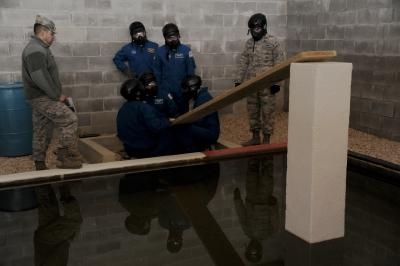Program Designed To Develop Leadership Skills Through Obstacle Course Challenges
To prepare for the rigors and dangers of space travel, astronauts attend different training scenarios at facilities all over the world. Some are highly specialized, immersive environments such as underwater tanks containing full mock ups of the international space station to practice functioning in weightless environments. There are also facilities used by others that can be repurposed to suit the astronauts' needs.

Maxwell Air Force Base's Squadron Officer College Project X leadership reaction course and the Vigilant Warrior training complex here are two facilities that Peggy Whitson, the NASA Johnson Space Center in Houston training lead for astronaut expeditionary skills, sought out to provide a unique training opportunity for its astronauts.
Designed to develop leadership skills, the LRC and vigilant warrior field exercises are a series of obstacle course challenges that students attending schools on Maxwell Air Force Base, AL go through as teams. The training was modified over the course of a year to fit the astronauts' training needs in a coordinated effort between NASA and the Academy of Military Science here on Maxwell AFB, said Lt. Col. Reid Rasmussen, the AMS commander.
Six American and international astronauts participated in training events at the LRC, and the VWTC here, March 3-5. "The way we ran the LRC for NASA is very different than how we would run it for our students," Rasmussen said. "They are more highly trained and come with a much broader skill set than your average lieutenant shows up with."
The events were designed to provide the astronauts with unique training opportunities based on requirements provided by NASA. The exercise pitted the astronauts against a specific obstacle goal to be achieved within a time limit and under a specific set of rules. They combined a set of physical and mental challenges to test the astronauts' core leadership training requirements. The astronauts had to scale walls and climb ropes, cross wide gaps with ropes and transport simulated wounded people, all while staying in a safe zone to achieve their goals. To make the situation more challenging some of the exercises cut off their ability to communicate. "We worked together in coming up with a scenario that would allow us to practice some more skills that give us a more extended duration working together," Whitson said.
While there is an established way of solving an obstacle, the central theme of the training was an emphasis on team work and intercommunication in unfavorable circumstances. "It was a very positive experience, putting us in a situation where we don't have the solutions," said Maj. Jeremy Hansen, a Royal Canadian air force astronaut. "These specific skill sets don't apply to our job of flying in space, but what really applies to our job is how six of us are going to live together in a tin can for six months and make sure that we operate in a very deadly environment and communicate all the things that are very important. If you get them wrong, there are significant prices to be paid."
Throughout the day, some of the exercises were designed to illustrate the difficulty of an inability to communicate and encouraged the astronauts to find alternatives. "Clear, concise, but effective communication is very important'" Whitson said. "Learning how to read accurate information back to ground so you can get the job done, particularly in a less than nominal situation is very important."
An environment like the International Space Station, where people from all over the world with different cultures and languages come together to accomplish a specific mission requires the astronauts to be able to easily adapt to new people and group dynamics, Whitson said. "It is imperative for us to develop the skill set and understanding of how to work with someone else, and it's important to be able to adapt easily to a new group of people and to know what techniques you might try differently to get the group to bond together and to build a stronger team."
After the LRC, the astronauts went to the VWTC site, where they spent a night out in the southern wild, where they built a shelter and set up communications equipment. The AMS instructors provided them with distractors and inputs to constantly test their ability to operate in a high stress environment. "Our instructor core gets to grow out this experience," Rasmussen said. "Just getting outside of your comfort zone as an instructor to broaden some of the things that we are allowing them to do is a way to make our instructors think a little bit more, be ready to debrief something they not have ever seen before. It's definitely beneficial to both sides. We just want to be a good partner and support NASA as they need it."
(USAF Photo. Six American and international astronauts work together to overcome an obstacle at the Project X leadership reaction course March 4, 2014, at Maxwell Air Force Base, AL. The training opportunity was provided by the Academy of Military Sciences and coordinated with the NASA Johnson Space Center in Houston to give the astronauts a unique and challenging training opportunity with different scenarios and ways of meeting core leadership training requirements.)
ANN Salutes Staff Sgt. Gregory Brook, 42nd Air Base Wing Public Affairs.
 Airbus Racer Helicopter Demonstrator First Flight Part of Clean Sky 2 Initiative
Airbus Racer Helicopter Demonstrator First Flight Part of Clean Sky 2 Initiative Diamond's Electric DA40 Finds Fans at Dübendorf
Diamond's Electric DA40 Finds Fans at Dübendorf ANN's Daily Aero-Term (04.23.24): Line Up And Wait (LUAW)
ANN's Daily Aero-Term (04.23.24): Line Up And Wait (LUAW) NTSB Final Report: Extra Flugzeugbau GMBH EA300/L
NTSB Final Report: Extra Flugzeugbau GMBH EA300/L Classic Aero-TV: 'Never Give Up' - Advice From Two of FedEx's Female Captains
Classic Aero-TV: 'Never Give Up' - Advice From Two of FedEx's Female Captains



